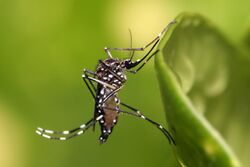Biology:Nematocera
| Nematocera | |
|---|---|

| |
| Aedes aegypti, a disease-carrying mosquito | |
| Scientific classification | |
| Domain: | Eukaryota |
| Kingdom: | Animalia |
| Phylum: | Arthropoda |
| Class: | Insecta |
| Order: | Diptera |
| Suborder: | Nematocera Duméril, 1805[1] |
| Infraorders[3] | |
The Nematocera (the name meaning "thread-horns") are a suborder of elongated flies with thin, segmented antennae and mostly aquatic larvae. This group is paraphyletic and contains all flies but species from suborder Brachycera[4] (the name meaning "short-horns"), which includes more commonly known species such as the housefly or the common fruit fly. The equivalent clade to Nematocera is the whole Diptera, with Brachycera as a subclade. Families in Nematocera include mosquitoes, crane flies, gnats, black flies, and multiple families commonly known as midges. The Nematocera typically have fairly long, fine, finely-jointed antennae. In many species, such as most mosquitoes, the female antennae are more or less threadlike, but the males have spectacularly plumose antennae.
The larvae of most families of Nematocera are aquatic, either free-swimming, rock-dwelling, plant-dwelling, or luticolous. Some families however, are not aquatic; for instance the Tipulidae tend to be soil-dwelling and the Mycetophilidae feed on fungi such as mushrooms. Unlike most of the Brachycera, the larvae of Nematocera have distinct heads with mouthparts that may be modified for filter feeding or chewing, depending on their lifestyles.
The pupae are orthorrhaphous which means that adults emerge from the pupa through a straight, longitudinal seam in the dorsal surface of the pupal cuticle.
The bodies and legs of most adult Nematocera are elongated, and many species have relatively long abdomens.
Males of many species form mating swarms like faint pillars of smoke, competing for females that visit the cloud of males to find a mate.
Families
These families belong to the suborder Nematocera:[3][5][6]
- Anisopodidae Knab, 1912 - wood gnats or window-gnats
- Axymyiidae Shannon, 1921
- Bibionidae Fleming, 1821 - march flies and love bugs
- Blephariceridae Loew, 1861 - net-winged midges
- Bolitophilidae Winnertz, 1863
- Canthyloscelididae Enderlein, 1912
- Cecidomyiidae Newman, 1835 - gall midges or gall gnats
- Ceratopogonidae Newman, 1834 - biting midges
- Chaoboridae Newman, 1834 - phantom midges
- Chironomidae Newman, 1834 - chironomids or nonbiting midges
- Corethrellidae Edwards, 1932 - frog-biting midges
- Culicidae Meigen, 1818 - mosquitoes
- Cylindrotomidae Schiner, 1863 - cylindrotomid crane flies
- Deuterophlebiidae Edwards, 1922 - mountain midges
- Diadocidiidae Winnertz, 1863
- Ditomyiidae Keilin, 1919
- Dixidae Schiner, 1868[7] - meniscus midges
- Hesperinidae Schiner, 1864
- Keroplatidae Rondani, 1856 - predatory fungus gnats
- Limoniidae Rondani, 1856 - limoniid crane flies
- Lygistorrhinidae Edwards, 1925 - long-beaked fungus gnats
- Mycetophilidae Newman, 1834 - fungus gnats
- Nymphomyiidae Tokunaga, 1932
- Pachyneuridae Schiner, 1864
- Pediciidae Osten Sacken, 1859 - hairy-eyed crane flies
- Perissommatidae Colless, 1962
- Psychodidae Newman, 1834 - moth flies or drain flies
- Ptychopteridae Osten Sacken, 1862 - phantom crane flies
- Rangomaramidae Jaschhof & Didham, 2002
- Scatopsidae Newman, 1834 - minute black scavenger flies or dung midges
- Sciaridae Billberg, 1820 - dark-winged fungus gnats
- Simuliidae Newman, 1834 - black flies
- Tanyderidae Osten Sacken, 1880 - primitive crane flies
- Thaumaleidae Bezzi, 1913 - trickle midges
- Tipulidae Latreille, 1802 - large crane flies
- Trichoceridae Rondani, 1841 - winter crane flies
- Valeseguyidae Amorim & Grimaldi, 2006
- † Ansorgiidae Krzemiñski & Lukashevich, 1993
- † Antefungivoridae Rohdendorf, 1938
- † Archizelmiridae Rohdendorf, 1962
- † Asiochaoboridae Hong & Wang, 1990
- † Boholdoyidae Kovalev, 1985
- † Cascopleciidae Poinar Jr., 2010
- † Crosaphididae Kovalev, 1983
- † Elliidae Krzeminska, Blagoderov & Krezmiñski, 1993
- † Eoditomyiidae Ansorge, 1996
- † Eopolyneuridae Rohdendorf, 1962
- † Grauvogeliidae Krzemiñski, 1999
- † Hennigmatidae Shcherbakov, 1995
- † Heterorhyphidae Ansorge & Krzemiñski, 1995
- † Hyperpolyneuridae Rohdendorf, 1962
- † Luanpingitidae Zhang, 1986
- † Mesosciophilidae Rohdendorf, 1946
- † Nadipteridae Lukashevich, 1995
- † Palaeophoridae Rohdendorf, 1951
- † Paraxymyiidae Rohdendorf, 1946
- † Pleciofungivoridae Rohdendorf, 1946
- † Procramptonomyiidae Kovalev, 1983
- † Protendipedidae Rohdendorf, 1951
- † Protopleciidae Rohdendorf, 1946
- † Protorhyphidae Handlirsch, 1906
- † Protoscatopsidae Rohdendorf, 1946
- † Serendipidae Evenhuis, 1994
- † Siberhyphidae Kovalev, 1985
- † Strashilidae Rasnitsyn, 1992
- † Tanyderophrynidae Rohdendorf, 1962
- † Tethepomyiidae Grimaldi & Arillo, 2009
- † Tillyardipteridae Lukashevich & Shcherbakov, 1999
- † Tipulodictyidae Rohdendorf, 1962
- † Tipulopleciidae Rohdendorf, 1962
- † Vladipteridae Shcherbakov, 1995
References
- ↑ Sabrosky, C.W. (1999). "Family-Group Names in Diptera". Myia 10: 1–360. http://www.online-keys.net/sciaroidea/add01/Thompson_et_al_1999_family_group_names.pdf. (page 358)
- ↑ Savage, Jade; Borkent, Art; Brodo, Fenja; Cumming, Jeffrey M. et al. (2019). "Diptera of Canada. In: Langor DW, Sheffield CS (Eds) The Biota of Canada – A Biodiversity Assessment. Part 1: The Terrestrial Arthropods". ZooKeys (819): 397–450. doi:10.3897/zookeys.819.27625. PMID 30713456.
- ↑ 3.0 3.1 Pape, Thomas; Blagoderov, Vladimir; Mostovski, Mikhail B. (2011). "Order Diptera Linnaeus, 1758. In: Zhang, Z.-Q. (Ed.) Animal biodiversity: An outline of higher-level classification and survey of taxonomic richness". Zootaxa 3148. doi:10.11646/zootaxa.3148.1.42. ISBN 978-1-86977-849-1. ISSN 1175-5326. https://www.mapress.com/zootaxa/2011/f/zt03148p229.pdf.
- ↑ Wiegmann BM, Trautwein MD, Winkler IS, Barr NB, Kim JW, Lambkin C (2011). "Episodic radiations in the fly tree of life.". Proc Natl Acad Sci U S A 108 (14): 5690–5. doi:10.1073/pnas.1012675108. PMID 21402926. Bibcode: 2011PNAS..108.5690W.
- ↑ Greenwalt, D.; Kjærandsen, J. (2019). "Fungus Gnats Online". http://sciaroidea.info/taxonomy/40255.
- ↑ ""Nematocera" (Non-Brachycera)". https://bugguide.net/node/view/14927.
- ↑ Schiner, I.R. (1868). Diptera. vi In [Wullerstorf-Urbair, B. von (in charge)], Reise der osterreichischen Fregatte Novara. Zool. 2(1)B.. Wien: K. Gerold's Sohn. pp. 388pp., 4 pls.
- Borror, D. J., DeLong, D. M., Triplehorn, C. A.(1976) Fourth edition. An introduction to the study of insects. Holt, Rinehart and Winston. New York, Chicago. ISBN:0-03-088406-3
- Arnett, R. H. Jr. (2000) Second edition. American insects. CRC Press, Boca Raton, Londres, New York, Washington, D. C. ISBN:0-8493-0212-9
External links
Wikidata ☰ Q27605 entry
 |

